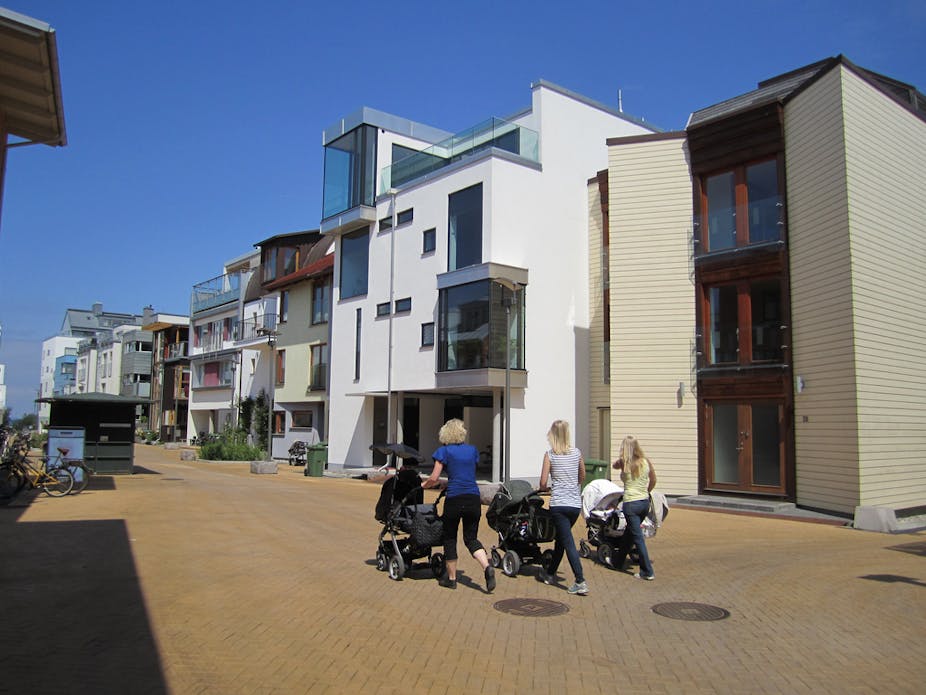In August, Liberal MP Peter Phelps delivered a passionate rant in the NSW Upper House in which he called traffic lights a “Bolshevist menace”. He argued that traffic lights are on par with state repression of individual liberty.
Instead, he demanded, we need more roundabouts: “Roundabouts represent freedom. Roundabouts represent liberty.”
It was the sort of quirky tirade that, while providing amusing “filler” for news agencies, usually offers no worthwhile argument and quickly fades from memory. Certainly, the Roads Minister Duncan Gay moved swiftly to quash any ideas about removing traffic lights.
But perhaps Phelps was on to something; he just wasn’t thinking radically enough.
Strip the signs away
What he could have pointed to was the urban design and traffic engineering concept of “shared space” (or “naked streets”). This idea strips away almost all traditional street elements – such as signs, traffic lights, pedestrian barriers, road markings and kerbs – in order to make those streets work better.
The informal sharing of streets has a long history, but has had a “rebirth” in this new approach, with its roots in the Dutch woonerf design principles that emerged in the 1970s.
The woonerven were streets where innovative paving, landscaping and other urban design measures allowed pedestrians, cyclists and children to share the road with slow-moving cars.
There has been a growing adoption of these ideas in an Anglo-American context as “shared spaces”. British urban designer Ben Hamilton-Baillie has been the best-known advocate.
More risk makes roads safer
Why a rebirth? Since the mid-twentieth century, when planners, engineers and governments began to grapple with huge increases in car use, street design has been dominated by the idea that potential conflict between vehicles and other users can be engineered out.
Smooth traffic flow and safety is supposedly achieved by controlling the movement of traffic with engineering and enforcement. We set up lane segregation, speed bumps, traffic lights, speed cameras, and so on.
The late Hans Monderman, a Dutch traffic engineer, pioneered shared space design. He summarised the problem of the emphasis on segregation, control devices and regulation:
“A wide road with a lot of signs is telling a story. It’s saying: ‘Go ahead, don’t worry, go as fast as you want, there’s no need to pay attention to your surroundings.’ And that’s a very dangerous message.”
Seemingly paradoxical, the underlying concept of shared spaces is that introducing risk can improve road safety. This “second generation” approach draws heavily on the field of behavioural psychology to better understand how the environmental context of streets influences behaviour.
It puts all street users together in a shared, largely undifferentiated space. It emphasises the importance of speed, eye contact and interaction. It builds a sense that the street is shared. The idea is to encourage people to take responsibility for their actions.
What emerges is a kind of “psychological traffic calming.”
Big in Europe, but catching on here
Around the world, but especially in Europe (where the European Commission sponsors a shared space project involving seven countries), there are hundreds of implemented schemes based on these principles.
In Australia there are very few. But a growing interest and acceptance can be seen in the City of Bendigo’s 2008 Australia award for Urban Design, to which its shared space scheme contributed significantly.
Existing studies of such schemes have found that, in the appropriate settings, they are generally beneficial. They tend to have lower vehicle speeds, fewer accidents and injuries. There is also evidence of reduced congestion and emissions.
Other positive aspects include less physical and visual clutter and more aesthetically attractive streets. These can contribute to enhanced feelings of liveability and improved social qualities.
Sometimes we need those Bolshevist traffic lights
There are caveats though – shared spaces can’t be deployed everywhere. Even their most passionate advocates, such as Hamilton-Baillie and Monderman, acknowledge the need for controlled highways and roads.
Also, strong concerns have been raised about potential impacts that shared spaces can have on more vulnerable street users. These are users such as children, the elderly and people with a disability (particularly the blind and partially sighted), who are less able to engage drivers in the required “negotiation”.
Some cycling advocacy groups worry about subjective levels of safety and the possibility that feeling unsafe will discourage people from getting on bikes. It is here that the debate on shared spaces dovetails with an equally heated one around the benefits (or not) of segregated cycle paths.
There is no simple answer to whether shared spaces are “right”. A formal theoretical framework and coherent body of research around their worth is only just emerging, and their application has to be context-specific.
What does seem clear is that, when successful, they help balance conflicting social and movement roles in streets. This balance gives pedestrians and cyclists more attractive and enjoyable streets than they often currently experience in our cities.

